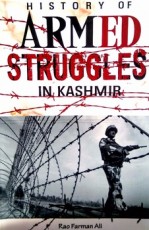Om Publications

History of Armed Struggles in Kashmir
Rao Farman Ali
₹1495 ₹1495 (0% off)
ISBN 13
9789383908646
Year
2017
The earlier years of the thirties of the 20th century marks the beginning of modern Kashmir. The Muslims of Jammu and Kashmir, for genuine reasons of having suffered for hundreds of years at the hands of imposed aliens and also for influences or fast changing social and political scenario at the international and local level, were developing a growing concern to start organised struggle against the present autocratic rule.
It was in this backdrop that a political organisation : All Jammu and Kashmir Muslim Conference was formed on 21st June 1931. Only after 21 days i.e. 13th July 1931, Police firing on agitating procession inside the Central Jail took toll of more than two dozen souls and the day is now remembered as the State Martyr’s Day. This event unleashed terror all round. All sections of people including women protested and a list of women martyrs was added to the resistance history of the State. The Muslim Conference broke into two groups; National Conference was born out of it. Freedom movement was moving ahead very fast side by side with the freedom struggle of the sub-continent. After the World War II, Britain planned to leave the sub-continent acceding to the demand of dividing British India into the dominions—India and Pakistan. The Princely States were given the option to either accede to India or Pakistan. 562 out of 565 merged to either of the two Dominions before 14th and 15th August 1947 (Respective dates of formation of Pakistan and India). The Dogra ruler of Kashmir wished to be Independent and sign a Standstill agreement. He delayed the process till mid October, 1947. Situation went murky in October 1947 and the State fell apart to the Control of the newly born Dominions of India and Pakistan. Both countries have been accusing and counter accusing each other for the conditions existing all these years till date. Over this period of 70 years the two countries have grown to the stubborn stands of “Integral Part” and “Jugular Vein” with complete disregard to the aspirations of victim Kashmiris.
The book gives even the minutest details of the Kashmir issue. Raids of the tribesmen, Maharaj’s seeking help from India, signing the Instrument of Accession, Indian Army landing in Kashmir, India’s taking the Issue to the United Nations, India’s commitments of deciding the Issue by Plebiscite, The U.N. Resolutions, Article 370 of Indian Constitution, formation of State Constituent Assembly, Delhi Agreement, Dixon Plan, Ousting of Shaikh Muhammad Abdullah, Indo-Pak Wars, Tashkant Agreement, Simla Agreement, Indira -Abdullah Accord, Lahore Declaration, Agra Summit, Musharraf’s 4-point formula so on and so forth. In this sense the book is of great value to the common reader, as well as to a serious reader who is interested to know and investigate any further dimensions of the Kashmir Issue. People are quite often talking of the U.N Resolutions on Kashmir, or even of Article 370 and the Special Status of Kashmir, or even about various bilateral Agreement and other historical documents but quite possibly most of them have never had any access to peruse these documents. The author has done a good job to compile these in Appendices of the Book. A good service indeed. The whole material is available at hand.